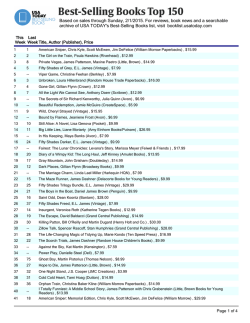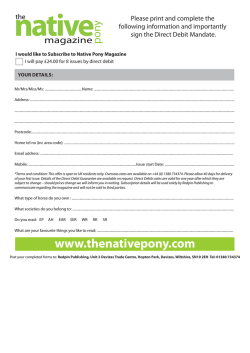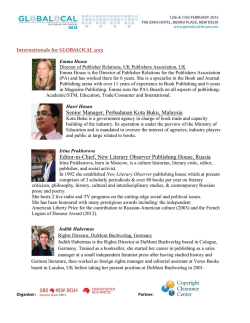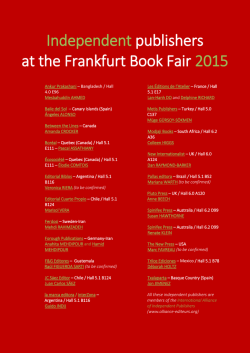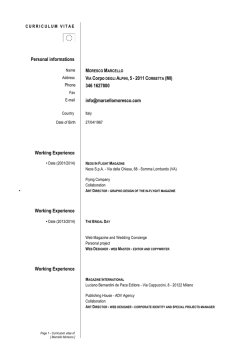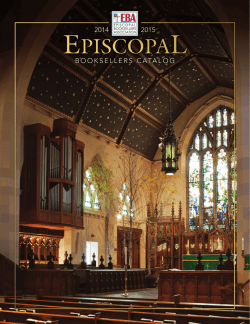
PDF is also available
1 W3C DIGITAL PUBLISHING INTEREST GROUP UPDATE Tzviya Siegman, Wiley, and Ivan Herman, W3C eBookCraft Conference, Toronto, Canada 2015-03-11 This work is licensed under a Creative Commons Attribution 3.0 License, with attribution to W3C Copyright© 2015 W3C® (MIT, ERCIM, Keio, Beihang) 2 DPUB IG ORIGINS • The publishing industry is, probably, the most important user of W3C’s Web technologies after (traditional) browsers: • almost all journals, magazines, etc, have an online version these days • scholarly publishing cannot exist without the Web any more • EPUB is, essentially, a frozen and packaged Web site • The quality requirements of the publishing industry are very high: • high quality typesetting, graphics, etc. • new forms of publishing will be based on high level of interactions, rich media, … • common document and data publishing comes to the fore 3 DPUB IG ORIGINS (CONT.) • But… the publishing industry had been in an entirely “passive” mode v.a.v. Web technologies • no participation in the development of fundamental Web technologies • W3C (and other standard bodies) hardly know about the requirements that this industry may have • the potential synergy between Web developers and publishers is missed out • Consequence: Working Groups at W3C set their priorities without knowing about, and considering, the publishing industry 4 DPUB IG ORIGINS (CONT.) • W3C and IDPF organized a series of exploratory workshops in 2012 to create a missing synergy among communities • The W3C Digital Publishing Activity and the Digital Publishing Interest Group was formally chartered in May 2013 • DPUB IG has weekly teleconferences and annual face to face meetings • next in 2015 – semi annual F2F: 26 May in NYC 5 DPUB IG MISSION “ The mission of the Digital Publishing Interest Group (DPUB IG) […] a forum for experts in the digital publishing ecosystem […] for technical discussions, gathering use cases and requirements to align the existing formats and technologies (e.g., for electronic books) with those used by the Open Web Platform […] 6 DPUB IG MISSION EXPLAINED • Experts familiar with the ins and outs of digital publishing and its associated industry groups identify issues that are not addressed by the Open Web Platform • Our goal is to raise issues to W3C working groups who can update (or develop) specs based on our information. We often delegate members to the WGs as well • DPUB IG has task forces with leads to focus attention on specific issues and collaborate with other WGs See our website for more detail. SO, WHO DOES THE WORK? 8 EVERYBODY DOES THE WORK! • IDPF has been writing specs for digital publishing for 15+ years, using W3C standards as a basis • DPUB IG highlights issues in OWP (W3C) that do not support the needs of digital publishing and learns from the W3C • W3C WGs update specs as needed to reflect needs of digital publishing and the broader web community 9 (CURRENT) DPUB IG TASK FORCES • • • • Annotations: led by Rob Sanderson Layout and Styling (aka Pagination): led by Dave Cramer Metadata: led by Bill Kasdorf and Madi Solomon Content and Markup: led by Tzviya Siegman • Accessibility: led by Deborah Kaplan and Charles LaPierre • STEM: led by Peter Krautzberger 10 ANNOTATIONS • Published an Annotation Use Cases • Activity and work has shifted to the Web Annotations Working Group • the work aims at annotation for all forms of Web Documents, whether in a browser or an eBook • the first Working Group at W3C joining forces of both browser and publishing industries from the start 11 PAGINATION AND LAYOUT • Published Requirements for Latin Text Layout and Pagination • requirements for print and digital publishing from HTML and CSS using the Latin alphabet • not a static document, new releases will come • Work with CSS WG to publish the CSS Inline Layout Module Level 3, a draft that enabling drop caps and stick-up caps in CSS • Participation (and gathering requirements) in the CSS WG’s new work standard pagination control • as opposed to the current, wildly differing solution used by the industry 12 METADATA • Interviewed publishing experts in metadata • Published DPUB IG Metadata Task Force Report • a note summarizing findings in interviews • discovered that OWP has the tools that publishers seek, but many in publishing are not familiar with tools • this group can aid the publishing industry in using OWP tools to implement existing vocabularies 13 CONTENT AND MARKUP • Goal is to provide a standard way to add a logical structure on top of (but staying compatible with) HTML • e.g., identification of various types of sections, index terms, glossaries, etc. • Working with a W3C Working Group that develops such extensions for accessibility purposes (called ARIA) • Proposed preliminary list of terms to as a module of ARIA • terms provide native HTML elements with specific semantic meaning appropriate to digital publishing • working in the context of ARIA provides increased accessibility 14 ACCESSIBILITY • Drafted use cases related to accessibility and personalization in digital publishing • Reviewing W3C accessibility documentation (UAAG, WCAG, and ATAG) to assess whether the documents reflect the needs of digital publishing and whether publishers are using the documents 15 STEM • Conducted initial interviews with STEM experts to get an idea of major pain points in digital publishing • Preparing pointed survey to refine information gathered in interviews 16 WHAT'S NEXT? • Continue our task forces with targeted deadlines and deliverables • Involve DPUB IG members in the planning and development of EPUB-WEB • this may lead to the creation of new task forces 17 WHAT'S NEXT? EPUB-WEB • IDPF and W3C published joint vision of future of digital publishing in a white paper entitled “Advancing Portable Documents for the Open Web Platform: EPUB-WEB” • White Paper is available at http://w3c.github.io/epubweb/ • Provide feedback at https://github.com/w3c/epubweb/issues 18 EPUB-WEB IS A VISION FOR THE FUTURE 19 THE EPUB-WEB VISION • Portable documents are fully native citizen of the Web • Separation between online (i.e., the “Web”) and portable (i.e., “EPUB”) is diminished to zero • This means: • content authored for primarily offline use can be used online by loading it into a browser • content authored for primarily online use can be easily saved as a portable document for offline use • these should be doable smoothly, solely based on the user’s interaction 20 THE VISION • Publishers can choose to utilize either or both of these publishing modes • Users can choose either or both of these consumption modes • Essential features flow seamlessly between on-line and off-line modes, like • cross-references, user annotations, access to on-line databases • licensing and rights management • etc. 21 FOR EXAMPLE: BOOK IN A BROWSER • On a desktop I may want to read a book just like a Web page: • easily follow a link “out” of the book • create bookmarks “into” a page in a book • use useful plugins and tools that my browser may have • create annotations Extract of Joseph Reaggle’s PhD on the Web 22 FOR EXAMPLE: BOOK IN A BROWSER (CONT.) • But: • sometimes I may need the computing power of my desk-top for, e.g., interactive 3D content • at other times I may also want to use a small dedicated reader device to read the book on the beach… • All these on the same book (not conversions from one format to the other)! 23 OTHER USE CASES FOR “OFFLINE” AND “ONLINE” USAGE • Scholarly publishing, including data sets, audio, video, programs, etc. • In-house publishing: companies (IBM, Boeing, Renault, etc.) publish digitally, with fast refresh time, and need both offline and online • Archiving and preservation of complete Web documents • Education materials including “book” content, interactive assessments, animations, a Web client for assessing test results, data for demos, and more HOW DO WE GET THERE? (TECHNICALLY) 25 HOW DO WE GET TO EPUB-WEB? • A strong cooperation between the different communities should be ensured • Technical challenges must be identified 26 SOME TECHNICAL CHALLENGES • Packaging format better adapted to Web needs (e.g., streaming), see Packaging on the Web draft • Document Structure: the current EPUB3 structure (“spine”, etc.) may have to be adapted to Web browsers, with possible defaults and possibility for user interactions • Identification: • general structures for unique ID-s so that documents would really be Web citizens • IDs for fragments so that it is possible to link into documents 27 SOME TECHNICAL CHALLENGES (CONT.) • Metadata: use of webby methods to identify products, provide means for rich metadata carried with the EPUB-WEB document • Further improvements on styling and pagination • Security, access control, and privacy • Presentation control: reconcile the different traditions of user control (e.g., font size) for documents 28 DPUB IG AND EPUB-WEB • DPUB IG already has task forces dedicated to working on many of the EPUB-WEB issues • The group will contribute to the formulation of the EPUB-WEB technical challenges, to a better understanding of the requirements • this may mean new task forces, e.g., for identification or packaging • EPUB-WEB will become a guiding principle for the group’s further work 29 HOWEVER… • EPUB-WEB does not replace EPUB3 (and upcoming EPUB3.1) at this moment • Many of the new features will also be part of EPUB3.1 (e.g., structural semantics) • The vision is a convergence of the EPUB3.* specifications and EPUB-WEB, eventually 30 UPCOMING EVENTS • 26 May, 2015: DPUB Face to Face @ Hachette Book Group, New York, NY, USA • 27 - 28 May, 2015: IDPF Digital Book 2015, New York, NY, USA 31 SOME REFERENCES DPUB IG Wiki https://www.w3.org/dpub/IG/wiki/Main_Page EPUB-WEB White paper: http://w3c.github.io/epubweb/ EPUB-WEB Issue list: https://github.com/w3c/epubweb/issues This presentation: http://w3c.github.io/dpub/ebookcraft-2015-03/ (PDF is also available for download) 32 DIRECT CONTACTS Tzviya Siegman, Wiley [email protected] Ivan Herman, W3C [email protected] THANK YOU!
© Copyright 2024
